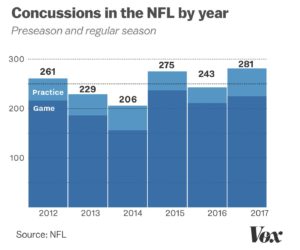The groundhog has seen his shadow, chips and beer are on sale, and there’s nary a car on the road; it must be Super Bowl Sunday! In a world where I have been historically found at a friend’s house, enjoying a cold one, betting on outcomes, and enjoying everything from the Star Spangled Banner to the commercial breaks, this marks the fourth year in a row that I have opted out of the TV-centric activity. Why?
I can no longer glamorize a game that I fear my son will one day take interest in.

Ya, I know…some other school…
I’m a huge football fan. I was a cheerleader in high school before performing in the marching band and the university mascot in college. Four out of five of my brothers played football. We enjoy watching games on Sundays, and going to games whenever possible.
Now, however, I see the way my 3-year-old learns behaviors and norms from me. If I show my interest in photography, I can be certain I’ll find him playing with my lenses. My husband installed a ceiling fan, and our son now carries screws in his pocket and a toy drill with him. Interests and behaviors are learned, and mimicked by young children. If I watch football, my son watches football. If I enjoy the game, or cheer on a team, or shout “Ooooh!” after a big hit, so does my son. And if we keep watching games, someday he’ll look up at me and say, “I want to play football,” to which my husband and I are unified, “ABSOLUTELY NOT.” And I am not the only parent that feels this way.
The links between CTE (chronic traumatic encephalopacthy) and football players is striking. According to CNN, CTE was found in 99% of deceased football players brains’ that were donated for study. Ninety-nine percent. And, the longer you play football, the more likely you are to have CTE.
CTE, which can only be diagnosed by autopsy, is a degenerative disease caused by concussions and repeated hits to the head. Despite significant efforts to decrease the number of concussions in the NFL, 2017 saw a six-year high:
The Intercept created a film, “Concussion Protocol” which depicts all 281 of these violent collisions this year, and more importantly, the dazed confusion after. If you have five minutes, it’s worth the watch:
The NFL is aware of the problem both for players and for ratings, and is doing its best to focus on player health. It continues to invest in concussion technology startups. However, this problem doesn’t start with the NFL. It starts much younger, with young men playing contact football as young as 6 – 8 years old, and suffering repeated hits through high school and university.
In 2015, a study in the journal Neurology found that former NFL players who began football before age 12 performed significantly worse on tests than those who started later in their teens. This held true even controlling for number of years played.
Indeed, two mothers in San Diego are suing Pop Warner and advocating a change in youth football after their sons separately committed suicide in their 20s after playing football only in their youth, and were later diagnosed with CTE. Illinois is writing legislation to ban tackle football before the age of 12. Yet, Pop Warner continues to fight for it’s right to tackle.
 The violence of this contact sport and the extreme pervasiveness of injury are much of the reason I won’t let my son play, and part of preventing his interest is not watching and idolizing the profession, including the Super Bowl. And if he’s not watching, I’m not watching. This should be as big a problem for advertisers as it is for the NFL.
The violence of this contact sport and the extreme pervasiveness of injury are much of the reason I won’t let my son play, and part of preventing his interest is not watching and idolizing the profession, including the Super Bowl. And if he’s not watching, I’m not watching. This should be as big a problem for advertisers as it is for the NFL.
Today we went for a hike instead. I’ll catch up on the commercials tomorrow…maybe.


11 Responses to Why I’m Not Watching the Super Bowl, The NFL’s Big Problem